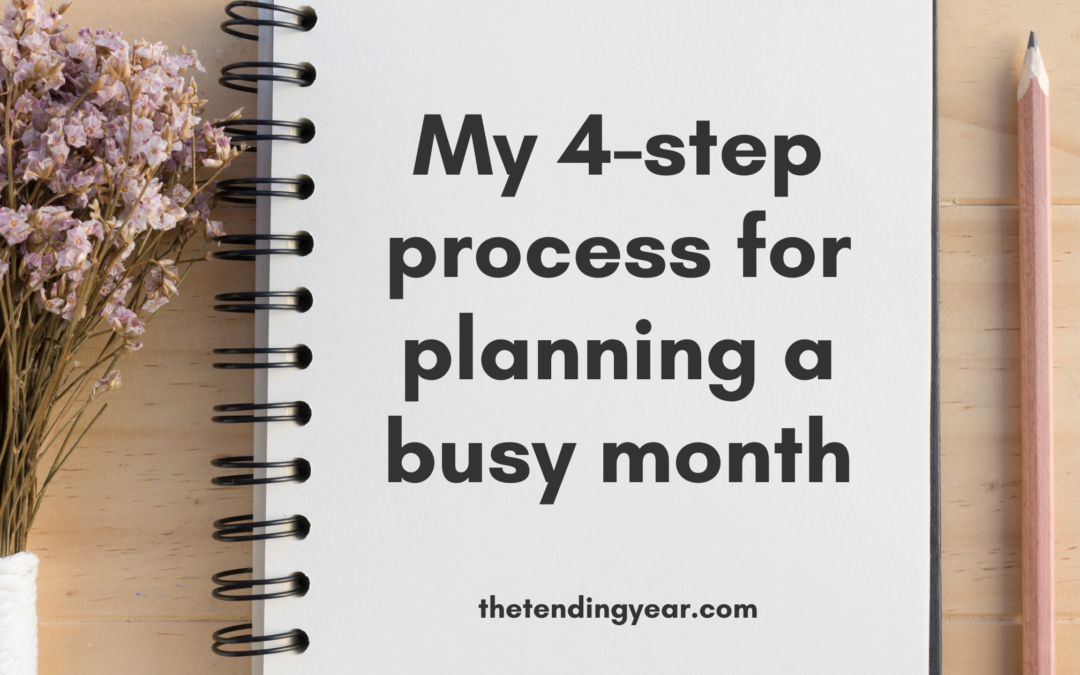This blog post originally was shared with my mailing list for The Tending Letter. You can subscribe to my newsletter at the bottom of the post.
I get lots of questions about my own time management practice. Today I’m sharing how I planned for my busy April without sacrificing my rest and self-care practices. My 4-step process is an experiment, so I’ll report back at the end of the month how it went for me. I encourage you to use it for inspiration!
Step 1: Look at an overview of my month.
Purpose: To ease into my planning process with more awareness of the flow of my month.
I use my bullet journal to track my daily and weekly to-do lists and I use my Google Calendar to track times I’ve cordoned off for 1-time or repeated meetings and appointments. I started by printing out weekly spreads of my Google Calendar for the next 4 weeks so I could see a spacial representation of what I’ve already committed to and booked. This gave me a lay of the land so I knew which weeks would be heavier or lighter, and I was pleased to see that I had a lot of open space to work with.
Step 2: Identify my self-care and rest needs for the month.
Purpose: To prioritize taking care of my physical and mental health.
I have some overlapping deadlines in April, and I want to make sure I don’t burn myself out by overworking due to unfortunate scheduling choices. To make sure I follow through on practicing self-care and resting, I compiled a list of what I know will help me take care of myself. Here are some of the things that showed up on my list: limiting the time I spend looking at screens, scheduling blank space/buffers between meetings, doing regular physical movement, taking proper mid-day breaks from work to make and enjoy lunch, and having very limited evening/weekend work responsibilities.
Step 3: Identify my key goals/commitments.
Purpose: To gain awareness of what I’m required to complete this month.
I skimmed through my emails that I’ve received in the last month to ensure that I wasn’t forgetting anything I’d committed to and then I generated a list of work goals and personal goals that were time-sensitive to April. I made an intentional decision not to write down any goals or tasks that can wait until May or June. In true Slow Productivity fashion, I’d rather take the extra space and time I could dedicate to getting ahead with work tasks and funnel it into my rest and self-care practices this month.
Step 4: Use the Must-Do Method to assign tasks to weeks.
Purpose: To ensure I’m working on the right task at the right time.
I’ve written about the Must-Do Method a lot (I even called it “the productivity tool that changed my life,” which I still stand behind). Created by the author Sarah Knight, the Must-Do Method asks you to take your long to-do list, prioritize it based on deadline, and schedule tasks accordingly so you can limit overwork and increase down time.
This April I’m creating and facilitating multiple workshops and presentations. Each of these includes behind-the-scenes labor like researching, custom creation of presentations and slide decks, and attending meetings (business side note: I usually charge my clients an hourly rate for doing these tasks—invisible labor is still labor). Because each project has many tasks, it is essential that I stagger when I am going to work on the different projects so that I don’t end up crunched on any particular day.
A final note on scheduling: In this stage of my life where my calendar is more open, I like to take more of a “rhythm” approach to completing my to-do list instead of a strict “routine” approach. Right now I prefer to assign tasks to a week and decide each day what tasks to work on. In some seasons of my life when I have less open time in my calendar, a strict routine works better. You might be working with a tighter schedule with less open time in your days so it may be better to assign projects/tasks to specific times and specific days. Please do what works best for you!
Additional Resources on Time Management
If you want to learn more about scheduling and planning, check out these blog posts:
newsletter and free resources
Sign up below to access six free resources and my newsletter, tending.

